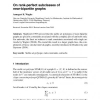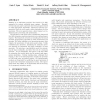107 search results - page 11 / 22 » Proximity Rank Join |
TREC
2004
13 years 10 months ago
2004
Web search engines exploit conjunctive queries and special ranking criteria which differ from the disjunctive queries typically used for ad-hoc retrieval. We wanted to asses the e...
4OR
2005
13 years 8 months ago
2005
Shepherd (1995) proved that the stable set polytopes of near-bipartite graphs are given by constraints associated with the complete join of antiwebs only. For antiwebs, the facet s...
SIGMOD
2004
ACM
14 years 8 months ago
2004
ACM
Ranking is an important property that needs to be fully supported by current relational query engines. Recently, several rank-join query operators have been proposed based on rank...
ICDE
2009
IEEE
14 years 10 months ago
2009
IEEE
Mediator-based data integration systems resolve exploratory queries by joining data elements across sources. In the presence of uncertainties, such multiple expansions can quickly ...
PODS
2005
ACM
14 years 2 months ago
2005
ACM
The full disjunction is a variation of the join operator that maximally combines tuples from connected relations, while preserving all information in the relations. The full disju...


